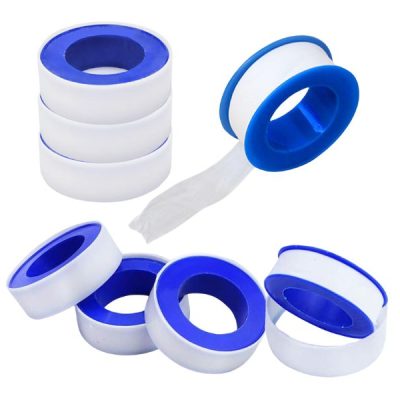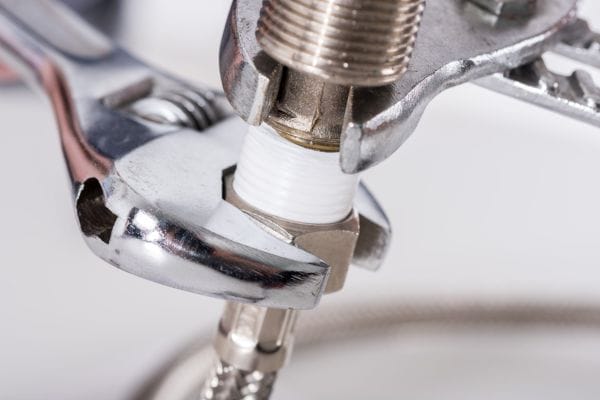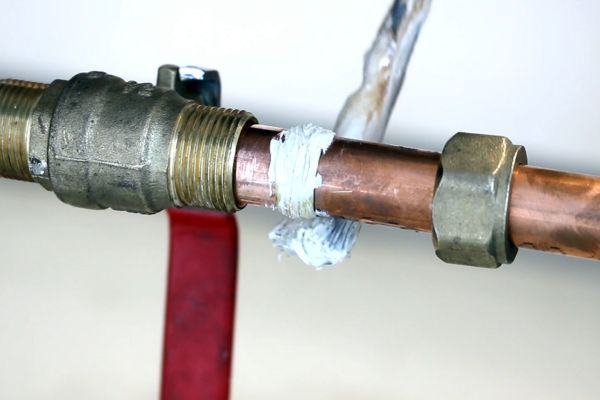When it comes to plumbing and hydraulic systems, one common area of confusion is the use of Teflon tape on compression fittings. Many people mistakenly believe that Teflon tape is necessary for creating a secure seal on these fittings, while others argue it’s entirely unnecessary and can even cause problems. In this post, we will explore the appropriate use of Teflon tape on compression fittings, delving into its benefits, potential issues, and best practices for achieving optimal results.
Teflon tape, also known as PTFE (Polytetrafluoroethylene) tape or plumber’s tape, is a thin, flexible tape used primarily for sealing pipe threads. It is made from a high-molecular-weight polymer that provides excellent non-stick properties and high resistance to chemicals, making it ideal for use in various piping applications. The tape is typically white, although other colors are available for different applications.
Standard Teflon Tape: This is the most commonly used type, suitable for general-purpose sealing of water, air, and gas pipe threads. It is usually white and can be used in temperatures ranging from -450°F to 500°F.
High-Density Teflon Tape: This tape is thicker and denser than standard Teflon tape, offering better-sealing properties and durability. It is often used in applications where a more robust seal is required, such as in high-pressure systems.
Gas Line Teflon Tape: Specifically designed for gas line applications, this tape is typically yellow and meets industry standards for sealing gas pipe threads. It is resistant to gas and hydrocarbons, ensuring a secure seal for gas connections.

Teflon tape is widely used in plumbing and hydraulic systems to seal pipe threads and prevent leaks. Its primary function is to fill the gaps and irregularities in the threads, creating a tighter seal that prevents fluid or gas from escaping. Common applications include:
Water supply lines: Teflon tape is used on threaded joints in water supply lines to prevent leaks and ensure a secure connection.
Hydraulic systems: In hydraulic systems, Teflon tape is used to seal connections and prevent hydraulic fluid leaks.
Air and gas lines: Teflon tape is used on threaded joints in air and gas lines to ensure a leak-free connection and maintain system pressure.
Non-stick surface: The non-stick properties of Teflon tape make it easy to apply and remove, allowing for easy disassembly of connections when needed.
Chemical resistance: Teflon tape is highly resistant to chemicals, making it suitable for use in various industrial applications where exposure to harsh chemicals is common.
Temperature tolerance: Teflon tape can withstand a wide range of temperatures, from extreme cold to high heat, without degrading or losing its sealing properties.
Flexibility: The tape’s flexibility allows it to conform to the shape of the threads, filling in gaps and creating a secure seal.
Misconceptions about the necessity of Teflon tape on compression fittings:
There are several common misconceptions about the use of Teflon tape on compression fittings. Many people mistakenly believe that Teflon tape should be applied to the threads of compression fittings to ensure a leak-proof seal. This misunderstanding likely stems from the widespread use of Teflon tape on threaded pipe connections, where it is indeed essential to fill gaps and prevent leaks. However, compression fittings function differently, relying on the mechanical force exerted by tightening the nut to compress the ferrule against the pipe and fitting body, thus creating a seal. Applying Teflon tape to compression fitting threads does not enhance the seal and can interfere with the proper compression needed for a secure connection.
Manufacturer recommendations:
Manufacturers of compression fittings generally advise against the use of Teflon tape on their products. This recommendation is based on the design and function of compression fittings, which do not rely on thread sealing to prevent leaks. The primary sealing mechanism in a compression fitting is the ferrule, which creates a seal when it is compressed between the nut and the fitting body. Adding Teflon tape can create a false sense of security, leading to improperly tightened connections and potential leaks. Furthermore, excess Teflon tape can shred and contaminate the fluid or gas passing through the system, causing additional problems.
Situations where Teflon tape is beneficial:
While Teflon tape is generally not recommended for compression fittings, there are specific scenarios where its use might be considered:
Threaded pipe connections: When dealing with threaded pipe connections that are part of the same system as compression fittings, Teflon tape can be used on the threaded connections to ensure a leak-free seal.
Preventing galling: In some cases, a small amount of Teflon tape might be used on the threads of compression fittings to prevent galling or seizing, especially when dealing with stainless steel fittings. However, care must be taken to avoid over-application and to ensure that the tape does not interfere with the sealing surface of the ferrule.
Temporary fixes: For temporary repairs or quick fixes, Teflon tape might provide a short-term solution, but it should not be relied upon for permanent installations.
Cases where Teflon tape can cause issues:
Interference with compression: Applying Teflon tape to the threads of compression fittings can interfere with the proper compression of the ferrule, leading to a poor seal and potential leaks. The tape can prevent the nut from being tightened adequately, compromising the integrity of the connection.
Contamination: Excess Teflon tape can shred during assembly and contaminate the fluid or gas passing through the system. This contamination can cause blockages, damage to equipment, and reduced system performance.
False sense of security: Relying on Teflon tape to seal compression fittings can lead to improperly tightened connections. Users might believe that the tape alone provides a sufficient seal, neglecting the importance of properly compressing the ferrule.
Incompatibility with certain materials: Teflon tape may not be compatible with all materials used in compression fittings, particularly some plastics, which can be affected by the chemicals in the tape. This can compromise the integrity of the fitting and lead to leaks or failures.
Gather Tools and Materials: Ensure you have Teflon tape, a pipe wrench, a clean cloth, and a wire brush.
Inspect the Fitting: Check the compression fitting and pipes for any damage, wear, or deformities that might affect the seal.
Clean the Threads: Use a wire brush to remove any debris, dirt, or old tape from the threads of the fitting and pipe. Wipe down the threads with a clean cloth to ensure they are free of contaminants. Proper cleaning ensures a tight seal and prevents leaks.

Start the Tape: Hold the end of the Teflon tape against the male threads of the fitting. Begin wrapping the tape around the threads in a clockwise direction (when looking at the end of the pipe). Wrapping in the correct direction ensures the tape does not unravel when the fitting is assembled.
Wrap Evenly: Apply the tape evenly and tightly, overlapping each layer by about half the width of the tape. This overlap ensures complete coverage and a better seal.
Number of Wraps: Generally, 2-3 wraps of standard Teflon tape are sufficient for most applications. For high-density tape, 1-2 wraps may be enough. Too many wraps can prevent the fitting from tightening properly, while too few may not provide an adequate seal.
Cover the Threads: Ensure that the tape covers the entire threaded area but does not extend past the threads onto the pipe. Excess tape beyond the threads can interfere with the sealing surface of the ferrule.
Insert the Pipe into the Fitting: Slide the nut and ferrule over the pipe, then insert the pipe into the fitting body.
Tighten by Hand: Begin tightening the nut onto the fitting body by hand, ensuring it threads on smoothly without cross-threading. Hand-tightening helps to align the threads properly and starts the compression process.
Use a Wrench: Once the nut is hand-tight, use a pipe wrench to further tighten the nut. Typically, 1-1.5 additional turns with the wrench are sufficient to compress the ferrule and create a secure seal. Avoid overtightening, as this can deform the ferrule and fitting, leading to leaks.
Check for Leaks: After assembly, test the connection by running water or applying the system’s operating pressure. Inspect for any signs of leaks. If leaks are detected, tighten the fitting slightly more and retest.
Fills Gaps: Teflon tape helps fill any small gaps or imperfections in the threads, ensuring a tighter fit and better seal. This is particularly important in ensuring that the compression fitting remains leak-free over time.
Smooth Thread Engagement: The tape provides a smoother surface for the threads to engage, reducing the likelihood of leaks that can occur due to misalignment or thread damage. This can be particularly beneficial in systems where vibration or pressure changes are common, helping to maintain a stable and secure connection.
Supplementary Seal: Although the primary seal in compression fittings is created by the compression of the ferrule, Teflon tape can act as a secondary barrier, adding an extra layer of protection against leaks.
Lubrication Effect: Teflon tape acts as a lubricant on the threads, which can help prevent the galling or seizing of metal components, particularly in stainless steel fittings. This lubrication makes it easier to disassemble the fittings without damaging the threads.
Simplifies Maintenance: The use of Teflon tape can simplify future maintenance tasks. If a fitting needs to be disassembled for any reason, the tape helps ensure that the threads remain intact and can be easily reassembled. This is especially useful in environments where regular inspections and maintenance are required.
Reusable Threads: By protecting the threads from direct metal-to-metal contact, Teflon tape helps preserve the integrity of the threads, allowing them to be reused multiple times without significant wear.

Barrier Protection: Teflon tape creates a barrier between the metal threads and the environment, which can help prevent moisture and corrosive substances from coming into contact with the threads. This is particularly important in outdoor or harsh environments where exposure to the elements can lead to rust and corrosion.
Chemical Resistance: The chemical resistance properties of Teflon tape make it suitable for use in a wide range of applications, including those involving aggressive chemicals. It helps protect the threads from chemical attack, ensuring a longer lifespan for the fittings.
Definition: Pipe dope, also known as thread sealant, is a paste-like substance applied to the threads of pipe joints. It fills the gaps and seals the threads to prevent leaks.
Application: Applied directly to the threads before assembly, pipe dope creates a chemical bond that helps prevent leaks. It is particularly useful in situations where the threads may be slightly damaged or irregular.
Types: There are various types of pipe dope, each formulated for specific applications, such as those resistant to high temperatures, pressure, or specific chemicals.
Definition: Anaerobic sealants are liquid adhesives that cure in the absence of air. When applied to the threads of pipe joints, they harden to form a strong, leak-proof seal.
Application: These sealants are applied to the threads and begin to cure once the fitting is assembled, creating a durable bond that is resistant to vibration and temperature fluctuations.
Types: Anaerobic sealants come in different formulations, including those designed for high-pressure systems, high temperatures, or specific chemicals.
Pipe Dope (Thread Sealant)
Pros:
Versatility: Effective on a wide range of materials, including metal and plastic.
Flexibility: Remains flexible after curing, allowing for adjustments without breaking the seal.
Easy Application: Simple to apply with a brush or applicator.
Cons:
Messiness: Can be messy to apply and may require cleanup.
Curing Time: This may require time to cure before the system can be pressurized.
Compatibility: Not all formulations are compatible with all types of pipes or chemicals.
Anaerobic Sealants
Pros:
Strong Seal: Creates a strong, durable seal that is resistant to vibration and thermal cycling.
Chemical Resistance: Highly resistant to a wide range of chemicals, making them suitable for industrial applications.
No Mess: Cleaner application compared to pipe dope, as it is a liquid that cures without residue.
Cons:
Permanent: Once cured, the seal can be difficult to break, making disassembly challenging.
Curing Conditions: Requires the absence of air to cure properly, which may not be suitable for all applications.
Specificity: This must be chosen carefully to match the specific materials and conditions of the system.
High-Pressure Systems: Anaerobic sealants are often preferred in high-pressure systems due to their ability to create a robust and vibration-resistant seal.
Chemical Exposure: In environments with high chemical exposure, anaerobic sealants or specialized pipe dope formulations that offer superior chemical resistance are preferred.
Temperature Extremes: Anaerobic sealants and specific high-temperature pipe dopes are better suited for systems exposed to extreme temperatures.
Ease of Disassembly: When future disassembly is anticipated, pipe dope might be preferable due to its flexibility and ease of adjustment.
Metal Pipes: For metal pipe connections, both pipe dope and anaerobic sealants are effective, but the choice may depend on the specific requirements of the system, such as pressure and temperature.
By understanding the various alternatives to Teflon tape, their advantages, and their limitations, users can select the most appropriate sealing method for their specific application. This ensures reliable, leak-free connections that are tailored to the demands of their plumbing or hydraulic systems.
In this post, we have explored the nuances of using Teflon tape on compression fittings, highlighting its benefits, potential issues, and alternatives. Following best practices when applying Teflon tape or choosing alternative sealing methods is crucial for achieving the best results in your plumbing or hydraulic systems. For further assistance or inquiries about our products, feel free to contact us.
No, Teflon tape is not typically necessary for compression fittings as they rely on the compression of the ferrule to create a seal. Applying tape to the threads can interfere with proper compression and lead to leaks.
For most applications, 2-3 wraps of standard Teflon tape are sufficient. For high-density tape, 1-2 wraps may be enough. Ensure the tape is applied evenly and tightly.
Teflon tape is generally safe for use with most metals and plastics, but it’s important to check manufacturer guidelines for compatibility, especially with certain plastic materials.
Alternatives include pipe dope (thread sealant) and anaerobic sealants. Each has its pros and cons and should be chosen based on the specific requirements of your system.
If you detect a leak, disassemble the fitting, clean the threads thoroughly, reapply the appropriate amount of tape, and reassemble. Ensure the tape is applied in the correct direction and the fitting is properly tightened.
No, Teflon tape should not be reused once it has been applied and removed. Always use fresh tape to ensure a proper seal and avoid potential leaks.